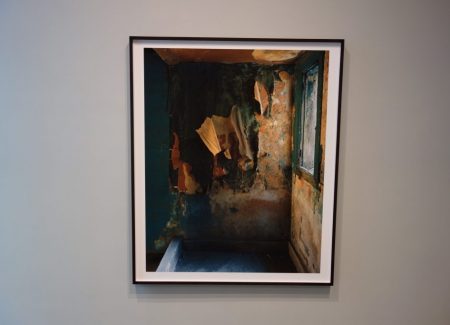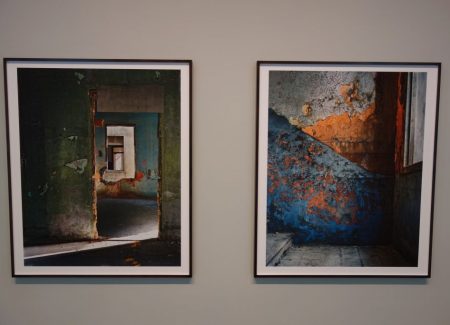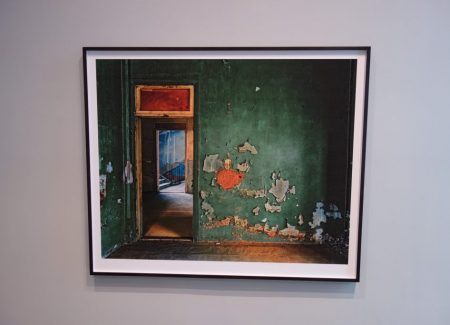JTF (just the facts): A total of 11 large scale color photographs, generally framed in brown and unmatted, and hung against white and grey walls in the main gallery space and the smaller back room. The largest piece (covering an entire long wall) is an archival inkjet print on canvas, made in 2008. It is sized 51×481 and is available in an edition of 2+2AP. The other 5 works in the front room (1 single image and 1 group of 4 images hung as a set) are UV cured ink on canvas, made in 2008 and 2011. They are sized either roughly 52×94 or 69×72, the wider single image in an edition of 2+2AP and the 4 works/set in editions of 5+2AP. The 5 works in the back room are inkjet prints, made in 2010. They are sized 60×50 or 72×60 (or reverse), and are available in editions of 10+2AP and 5+2AP respectively. (Installation and detail shots below.)
Steidl has recently published two monographs of these bodies of work, entitled 60 Feet Road (here) and Hotel Petra (here).
Comments/Context: Robert Polidori has made a long and successful photographic career out of closely inspecting surfaces. Over the years, his lushly detailed pictures have visually preserved countless sites of decay, from the disaster zones of New Orleans and Chernobyl to the faded grandeur of Havana and Versailles, each individual image a precise excavation of textural layers and a loving documentation of creeping decomposition. Few have paid such intense attention to the rich weariness of empty and forgotten spaces. For Polidori, each corner of peeling paint, floor marred by water stains, door frame with worn edges, and stairway with a broken railing offers an opportunity to excavate swept over stories and to uncover unlikely beauty.
Polidori’s recent images from the Hotel Petra in Lebanon travel these exact same artistic pathways, so much so that we might reasonably assume we have seen the photographs before. Damaged in the 1980s and boarded up for the following decades, the abandoned Beirut hotel is the perfect setting for Polidori’s careful examinations, and even though his approach to capturing its decomposed grandeur is altogether familiar, that doesn’t make his results any less lavish or satisfying.
Layers form the basis of many of his pictures. Cracking paint flakes off or tears like loose flimsy paper, revealing different substrata of color, encouraging us to walk back into history and remember when a white wall was once blue, or brown, or yellow, or when an angled stripe used to echo the slope of some adjacent stairs. Up close, these unravelings dissolve into expressive abstraction, the aggregation of marks and textural gestures coming together as though made by half a dozen separate painters over time.
Polidori also uses open doorways as a frequent mechanism for compositional layering. This technique allows us to see through the depth of space to rooms that telescope away from us, the architecture flattened by the camera into overlapping rectangles. When warmed by pure white light, these rooms echo with quiet reverence, long empty but still capable of moments of understated impressiveness.
If these were the only pictures in this show, we might rightly accuse Polidori of following his perfected formula too closely. But the other works on view here (from India) find Polidori taking some new risks and extending his interest in texture beyond the safe zone of gracefully fading interiors.
Polidori’s Mumbai pictures daringly step outside, and attempt to take in the tactile complexity of long views of improvised urban living, where dense slums, shanty towns, and settlements spread like a suffocating blanket. These “auto-constructed” cities lack the organizing structure of deliberate development, instead following a “dendritic” or branching structure, where one building is built upon the next in a never ending aggregation of space. From a raised vantage point, corrugated tin and plywood roofing materials undulate as far as the eye can see, with individual structures decorated with plastic sheeting, hanging laundry, and makeshift plumbing pipes. But making a single picture that faithfully takes in all of that detail is next to impossible.
To do a better job of capturing the inherent complexity of these places, Polidori has adapted his photographic approach, making multiple images of a given scene, each meticulously aligned so that the perspectives aren’t skewed and the source images can later be digitally stitched together to form a single panoramic picture. His 8×10 large format camera gives him the extreme detail he requires to scrutinize these exterior surfaces edge to edge, and then his exacting compositing amalgamates the visual components into one impossibly realistic photograph. The result is artworks that feel topographical – Amrut Nagar #3 takes in an engrossing 180 degree sweep of hillside construction, allowing the viewer to scan from left to right across four large frames to take in both the scale of the place and the immensity of its tiny detail.
This kind of precise photographic construction isn’t new of course – Andreas Gursky has been making monumental composite images for decades, and Clifford Ross has gone even further in his search for crisp high resolution perfection. What makes these pictures somewhat different is Polidori’s enduring interest in the power of texture and surface, and in the discoveries that can come from peeling back layers inside decaying spaces. His composites are direct conceptual extensions of his earlier single frame work, just technically expanded to encompass the even more richly varied subject matter to be found in these sprawls of humanity.
The centerpiece of this show is a 40 foot long mural sized photographic work entitled 60 Feet Road that takes these ideas to their logical end point. Constructed from 22 separate images taken along the entire length of the road, the resulting picture is one continuous panorama that never tilts long the lines of perspective – every inch is seen exactly square to the lens from roughly the same distance. While Ed Ruscha famously picked out all the individual buildings along the Sunset Strip, Polidori goes further, including every single transition and intermediate zone from one end to the other.
60 Feet Road is very much an artwork to get lost in. While the shifting light and the changing blue of the sky give away the actual passage of time, the picture seems to have stopped time everywhere at once, with various small scenes taking place in the shacks along the trash strewn canal like vignettes from a Pieter Bruegel painting. Quickly we are drawn into the up close investigation of surfaces – of tarps and water drums, of brick walls and rickety wooden overhangs, of rusty corrugated tin and stained concrete spillways, of every single human choice that went into the cacophony of communal architecture that now exists. The work is both map-like in its exacting replication of the spatial reality it documents, and somehow magical, showing us something our eyes could never actually see in the same way.
This show seems to be catching Polidori in a time of exciting artistic transition, where new ideas are forcing him to extend both his visual vocabulary and his underlying working methods. While there are certainly an endless line of dusty architectural relics waiting to be tenderly photographed by Polidori, I am glad to see him pushing beyond that low hanging fruit and continuing to test himself. The aching beauty of tactile ruins will always be his signature, but these composite pictures represent a definite fork in the road, and a promising way to breathe new life into the sophisticated study of surface.
Collector’s POV: The works in this show are priced as follows. The prints from Hotel Petra are either $34000 or $48000 based on size. The single large 60 Feet Road work is $125000, while the other works from Mumbai are $48000 (the set of 4 is available for $160000) and $65000 each. Polidori’s works are consistently available at auction, with recent prices ranging between roughly $7000 and $70000.













